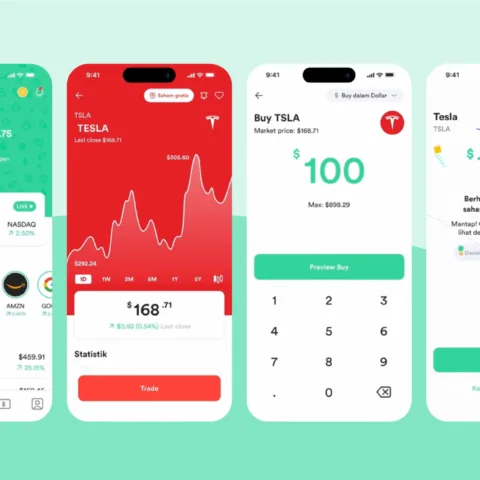 My first day on the Global Mobile Internet Conference was an amazing experience where I could learn many things about the mobile industry and the Internet directly from the world class champs. There are so many things I learned from following the keynote speakers at this GMIC, and one of the most interesting was the keynote from John Liu, Head of Google China. The topic that was delivered was 7 mobile internet trends in the world, and I think it is a knowledge that is relevant to the startups of Indonesia.
My first day on the Global Mobile Internet Conference was an amazing experience where I could learn many things about the mobile industry and the Internet directly from the world class champs. There are so many things I learned from following the keynote speakers at this GMIC, and one of the most interesting was the keynote from John Liu, Head of Google China. The topic that was delivered was 7 mobile internet trends in the world, and I think it is a knowledge that is relevant to the startups of Indonesia.
Indonesia itself is very popular with mobile and social media activity that often confuse people from all over the world, at least that’s the impression I got when talking to GMIC speakers and asked their impression of Indonesia.
So, what are the seven trend of mobile Internet in the future according to John Liu?
#1 Smartphone is the future
Of course this has practically become a reality where smartphone has almost a majority market share in big cities in the world, also in Indonesia. In fact, according to a study by Nielsen, it is estimated at the end of 2011 more than 50% market share in mobile in the U.S. will be dominated by smartphones.
John Liu showed the data that about China-made smartphone shipments which continue to rise since 2009 with average growth of 20% per year. And Liu also indicated that the smartphone market share from China continue to grow 10% every year and until 2014 is expected to reach 22% of the worldwide market.
This certainly will continue to expand outside of China, especially with the release of tablet computer products that slowly break down the barriers between desktop computers with mobile phones. This certainly will make products such as iPad and Galaxy Tab become increasingly common and dominated the computer and mobile market.
Based on my own observations in Beijing, there are plenty of youngsters who use iPhone and Android based smartphones. Nokia still dominates the more senior market, the same as in Indonesia, possibly because the brand is still quite good among the elderly.
#2 Search continues to drive mobile usage
Maybe Liu was a bit biased here because Google is a search engine company No. 2 in China, but the facts revealed are quite reasonable to me.
One of the research results Liu presented were taken from Nielsen Technology Report 2010, which measured the percentage of smartphone functions by the user. It shows that only 6% of smartphone users who use the TV feature, 56% use maps and direction, 59% to consume contents and 73% do a search using a smartphone. I think in Indonesia may have result more or less the same, unfortunately, the function of watching TV crowds in Indonesia do not own smartphones, but the feature-phone (Nexian, K-touch, Blueberries, etc.).
Another fact revealed by Liu, searching turned out to be one of the primary activities conducted by smartphone users when using the browser. Another thing I learned from Jay Sullivan, VP of Product Mozilla Inc., is that applications are very popular in smartphones but mobile browser will keep alive in order to facilitate certain functions, such as searching and browsing. Users will not be going to download all the applications that exist in the marketplace, they will only download critical and the rest will still be accessed using a browser.
#3 Mobile usage complements desktop
Liu displayed a chart that shows that the frequency of the high use of mobile search is on weekends, when the user is not on the desktop / laptop. This indicates that the desktop / laptop does not must “compete” with the smartphone, the user can use both comfortably. So, according to Google’s statistics, as traffic search declined from desktop, the traffic search of mobile increased.
According to data from Google Internal Data, 2009, Liu also stated that the use of PC / Desktop / Laptop in one day begin to rise around 10 am and began to decline at around 6 pm. For mobile use, connectivity tends to be stable in one day and have increased approximately 11 pm. This data explains that with the smartphone, users get a constant connectivity to the Internet when they are away from your laptop / desktop.
#4 Mobile is local
33% of searches made on the smartphone is a local search, to find the location of buildings, restaurants, malls, and others. I personally frequently use my smartphone to search locally. Another very interesting statistic is: after doing a search on smartphones, 61% of users make telephone contacts and 59% directly to the location he was looking for it.
When I’m stopped at Kuala Lumpur International Airport, there is a bluetooth transmitter that spread throughout the airport that if you turn on your smartphone bluetooth it will soon be given a notification if you want to download the application KLIA Deals or not. When you are at the airport in Kuala Lumpur, you can download the application KLIA Deals for your smartphone and through this application you can see all the discounts and promotions from all merchants in the area of the airport. I think this is very interesting, because the combination of “mobile” and “local” is fit even though the application only has value when you are at the airport. However, it is a nice blend between “mobile” and “local”.
#5 Mobile represents new and innovative media consumption
Mobile phones are the most personal technological device compared with other mobile devices. Often, there are many who say that it is better to left your purse at home, rather than a cell phone left behind at home. This does not mean there are effects of addiction to cell phones, but the personal relationship that exists between human-technology.
Because personal relationships are so strong, user behavior in consuming content and media also become distorted and very personal. The way a person can consume media is different from other people, it is the primary challenge for the media in the customization and personalization. Because of the different way to consume media, then the media also must communicate to the users in a different way as well.
Users want a more personal communication with the media, personal approach in the ads that appear on smartphones becomes critical issues for the communication between the media and consumer. First, the advertisements on the web tend to be more promotional, but now must be more interactive, communicative and personal.
#6 Imagination in Mobile devices
Smartphone can be considered an extension of human senses such as ears, eyes, mouth and brain (Shazam, Display, Google Goggles, Google Voice, Google Translate). From the technology side, the smartphone is still there in a very early stage and will continue to grow.
Opportunities for innovation in smartphone technology is still wide open, especially with so many limitations that still exist on the smartphone. For example, RFID technology credit card in the smartphone that enables smartphone users to pay anything using their cell phone, as has been applied in several countries in Europe.
This is just one small example, there are still many areas that can be explored from smartphone technology. Cameras, RFID, GPS, Bluetooth and of course there will be new technologies that continue to come that can be explored to be a solution for the user.
#7 Mobile is an open world
Again, maybe Liu somewhat biased with this point. For Google, the browser seems to have a higher priority than the marketplace. From the keynote delivered by John Liu, I concluded that Google via Android like to give an Open Web experience where users can access the Internet through Android devices, and not a small version of Internet that bundled through the application. Of course, this vision is what distinguishes between Google and Apple.
“Open” version which is more relevant for me is the mobile platforms that open the door wide for the users to customize their smartphones according to what they want. I think there is no smartphone in the world that is identical when viewed from the content. This is what sparked the smartphone revolution when previously the manufacturer determines what applications are available on our phones, and now that decision is in our hands.
—-
The points presented by John Liu I think is very relevant, including for the Indonesian market. And to be honest, lately I was a little frustrated with the lack of mobile application developers in Indonesia. Indonesia is a huge market for mobile applications, and so far there are about 20 developer enterprises specialized in mobile application.
Seriously, mobile programmer is a very very potential market and demand for mobile applications these days also have far exceeded the number of existing developers. Do not let developers from overseas should come and fill the gaps.
Agree?
Disclosure: DailySocial is one of the event partners of Global Mobile Internet Conference (GMIC) event.
Translated by Nita Sellya.










